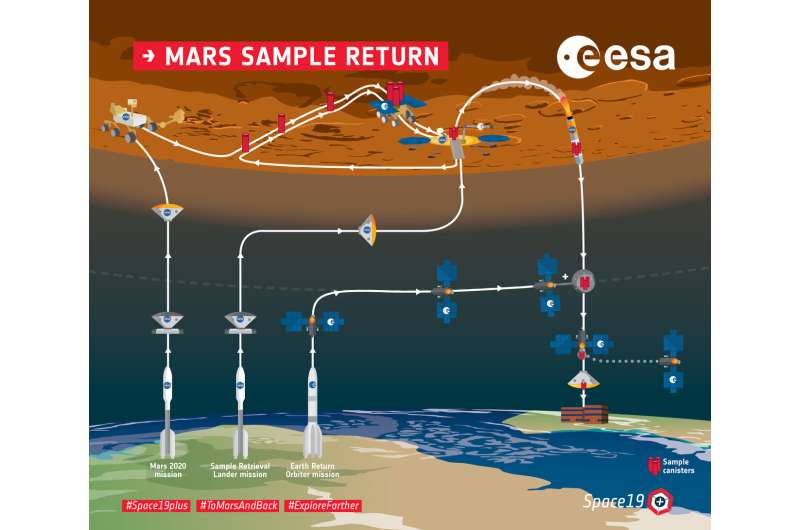Europe prepares for Mars courier

The first round-trip to the Red Planet will see a European orbiter bringing martian samples back to Earth. ESA is opening the door to industry to build the spacecraft that will deliver the precious rocks, dust and gas from Mars—the key to understanding whether life ever existed on our closest planetary neighbour.
This 'take-away' service is called the Earth Return Orbiter, and will be ESA's major contribution to the Mars Sample Return campaign. The ESA Orbiter will carry NASA's Capture and Containment and Return System, which will rely on the ESA-led spacecraft for transit to and from Mars.
Three launches from Earth and one from Mars—the first ever from another planet –, two rovers and an autonomous capture in Mars orbit are all part of an ambitious series of missions that ESA is embarking on together with NASA.
The campaign aims to bring at least 500 grams of samples back from the Jezero crater that once held a lake and contains an ancient preserved river delta. The rocks in the area preserve information about Mars' diverse geology.
NASA's Mars 2020 rover that is slated for launch in July 2020 will scientifically select the best samples to store in tubes and deposit them onto the martian surface for later retrieval.
ESA is also studying concepts for a small 'fetch' rover to scurry quickly across the martian surface to locate and recover the stored samples.

It would then carry them back to a football-sized canister that would be launched with a NASA Mars Ascent System—a small rocket.
The Earth Return Orbiter will capture the canister in orbit and transfer it safely to Earth, a return trip that will take about 13 months.
"We will have the responsibility of finding, capturing and transporting these precious martian treasures home for careful analysis in state-of-the-art labs on our planet," explains Sanjay Vijendran, ESA's Mars Sample Return campaign coordinator. "It's an interplanetary treasure hunt!"
Bringing Mars back to Earth
The Earth Return Orbiter is set to get onto the launch pad by 2026 from Europe's spaceport in Kourou, French Guiana. Through this call, ESA will be selecting a prime contractor for the spacecraft.
"The mission is becoming a reality, and we are proud to give European industry the chance to join the challenge," says Orson Sutherland, study manager for the Earth Return Orbiter.
The main challenges are the electric propulsion and power generation. "Not to forget finding and navigating the spacecraft to rendezvous with the football sized orbiting sample over 50 million km away from ground control," adds Orson.
The spacecraft will use technological heritage from ESA's most recently launched science mission, BepiColombo: both use electric propulsion and multi-stage detachable modules.
"Europe is ready to do its bit for the Mars Sample Return campaign, in close partnership with NASA, and is up to the challenge of putting the spacecraft onto the launch pad in 2026," says Orson.
Provided by European Space Agency





















